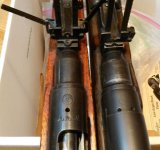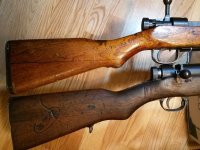You are using an out of date browser. It may not display this or other websites correctly.
You should upgrade or use an alternative browser.
You should upgrade or use an alternative browser.
Working on a jap type 38
- Thread starter mwells72774
- Start date
Gunplummer
New member
Late war 99's only had the blow hole and MUM on the receiver ring. I have never seen a 99 with the twin blow holes like a T-38, and the ejector box frame on a T-38 is actually part of the receiver. That is the quickest way to ID them.
As I said, I test the Japanese rifle by covering the receiver with a white towel. If after firing I find two black stains on the towel I chamber it to 257 Roberts/6.5mm50.
"If after firing I find two black stains on the towel I chamber it to 257 Roberts/6.5mm50" And no one wonders why. If the towel is stained black the barrel is shot out, when fired there is not enough pressure to seal the chamber with the case.
F. Guffey
Gunplummer
New member
There is really no mistaking a Type 30 for a Type 38 or 99. The difference is pretty obvious. The ejector area is way different than the T-38. Anyway, the chance of someone picking one up at a yard sale are pretty slim. The T-44 is marked as such and the receivers are identical to a T-38 except for the markings. Off and on both rifles were experimented with, but still retained the basic blow holes for each and the ejector systems also.
Gunplummer
New member
Mexican contract rifles with the Mexican stamp on the receivers. Only about half were delivered and then Mexico ran out of money.
broknwheel
Inactive
scope mount arisaka 38
I just picked up a 38 sporter, a gunsmith said he though the work was done in the 50's. I have to say it is one of the best jobs I have seen. I will post some pictures when I finish with the scope I am putting on. Every body knows how difficult it is to mount, I am working with a side mount so I can leave the peep site as it was done.Looking forward to nice new scope, to try some long distance shooting with a hot 257 Roberts.
I just picked up a 38 sporter, a gunsmith said he though the work was done in the 50's. I have to say it is one of the best jobs I have seen. I will post some pictures when I finish with the scope I am putting on. Every body knows how difficult it is to mount, I am working with a side mount so I can leave the peep site as it was done.Looking forward to nice new scope, to try some long distance shooting with a hot 257 Roberts.
Blindstitch
New member
Congratulations.
I have a scoped t38 and I've been thinking about picking up another. My only dislike is I wish it took a round that was findable at a big box store. But reloading has gave me great results.
I have a scoped t38 and I've been thinking about picking up another. My only dislike is I wish it took a round that was findable at a big box store. But reloading has gave me great results.
"if the receiver is the strongest in the world I should be able to chamber one to 8mm Remington mag. "
I don't think the magazine could be opened far enough, but as far as strength goes, why wouldn't one be able to rebarrel or rebore (not rechamber) an Arisaka to 8mm Rem Mag?
Jim
I don't think the magazine could be opened far enough, but as far as strength goes, why wouldn't one be able to rebarrel or rebore (not rechamber) an Arisaka to 8mm Rem Mag?
Jim
Gunplummer
New member
The Arisaka action was never touted as "The strongest action in the world". It was tested along with other WWII military issue rifles and was found to be the strongest in the group. Some rifles were awaiting future testing. I would be curious to see how the Russian bolt action stacked up against other rifles. Anything that looks as though it should be bolted to a tractor has to be tough.
I have rebarreled, recut chambers, cut+welded and made a lot of parts for Arisakas. For years I collected them. The T-38 is a somewhat stronger design, but I would not hesitate to rebarrel either a T-38 or a T-99 to 8mm Rem magnum. In my collection, I had a fine example of an Arisaka reworked by the US Military to 30-06, and it was marked as such. An endmill had been run down through the back of the receiver ring putting a notch in the back of both the upper and lower receiver locking lugs. It was a pretty hefty cut so that a 30-06 cartridge could be loaded down through the top. The whole gun was some weird green (parkerized?) color. Guffy is just miffed because the '03 Sprungfield was voted "The most likely to scar your face" rifle.
I have rebarreled, recut chambers, cut+welded and made a lot of parts for Arisakas. For years I collected them. The T-38 is a somewhat stronger design, but I would not hesitate to rebarrel either a T-38 or a T-99 to 8mm Rem magnum. In my collection, I had a fine example of an Arisaka reworked by the US Military to 30-06, and it was marked as such. An endmill had been run down through the back of the receiver ring putting a notch in the back of both the upper and lower receiver locking lugs. It was a pretty hefty cut so that a 30-06 cartridge could be loaded down through the top. The whole gun was some weird green (parkerized?) color. Guffy is just miffed because the '03 Sprungfield was voted "The most likely to scar your face" rifle.
Those Type 99's converted to .30-'06 were reportedly issued by the U.S. to South Korean reserves and militia forces during the Korean War. The ammunition was issued in M1903 clips, which worked fine.
I never fired one of those, but I have fired gunsmith-converted Type 99's (often called the ".30 caliber Jap" by U.S. troops), and in spite of the .003 oversize barrels, they shot quite well. (The Type 38 was called the ".25 caliber Jap".)
Jim
I never fired one of those, but I have fired gunsmith-converted Type 99's (often called the ".30 caliber Jap" by U.S. troops), and in spite of the .003 oversize barrels, they shot quite well. (The Type 38 was called the ".25 caliber Jap".)
Jim
Last edited:
Gunplummer
New member
I never bothered with bayonets, but that one had the matching serial # bayonet and was marked ROK, (Republic of Korea) so I kept it with the rifle. It has been a while since I sold out, but if I remember correctly the left side of the receiver ring was stamped US CAL .30 This was a serious stamp and probably was done with a punch press. These guns had recut chambers and were not rebarreled. So much for not using 30-06 brass to make 7.7 brass. I never fired it, but did have a civilian convert I picked up and it did not shoot to well. Maybe you have seen the T-99's converted to .300 Savage at shows and yard sales. I had bought one once for parts and ended up using it to hunt deer. @ 100 yards with factory Remington ammo it was unbelievably accurate. I also had one recut to .308 and that shot lousy. Hit or miss on the conversions I guess. I still have one I converted to 7.62x39 and I have taken head shots on deer with that one, it so accurate. The weird thing is, I tried a couple different bullets in .311 diameter and the 150 grain .308 diameter Remingtons shoot the best. Go figure.
Last edited:
If it was full military then I wouldnt touch it but its been shortened and put in a sporter stock. Sadly it still has the mum
If that's the case, and the receiver hasn't been modified in any way, you could always "restore" it. Barrels, stocks and hardware frequently show up on eBay and other sources.
Just a thought...
The Japanese probably got Metford rifling and the 7.7 caliber from the .303 British, since Japan and Britain were close allies until the militarists came into control in Japan and took the path that led to WWII. There were three different 7.7 cartridges. The 7.7 rimless was used in the Type 99 rifle; the 7.7 semi-rimmed was used in the feed-strips of the Hotchkiss type heavy machinegun; the 7.7 rimmed was the .303 British, used in the Imperial Navy's license-built Lewis guns. The latter were used in flexible aircraft mounts and also as ground guns by the Navy landing teams (called "Jap Marines" by our troops).
The three types of 7.7 are not interchangeable.
Jim
The three types of 7.7 are not interchangeable.
Jim


